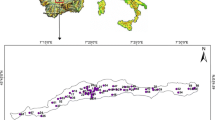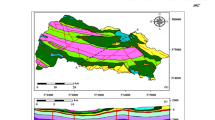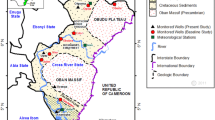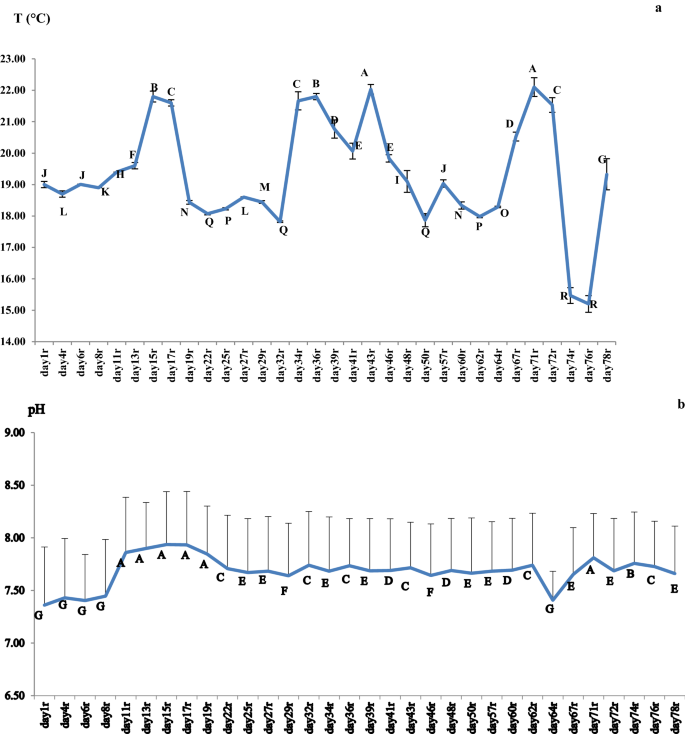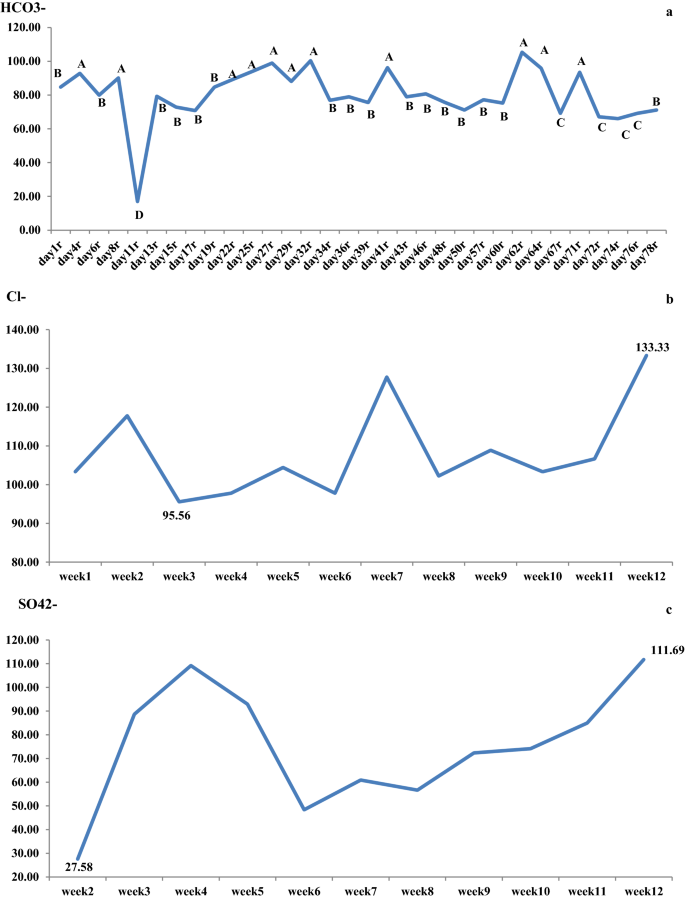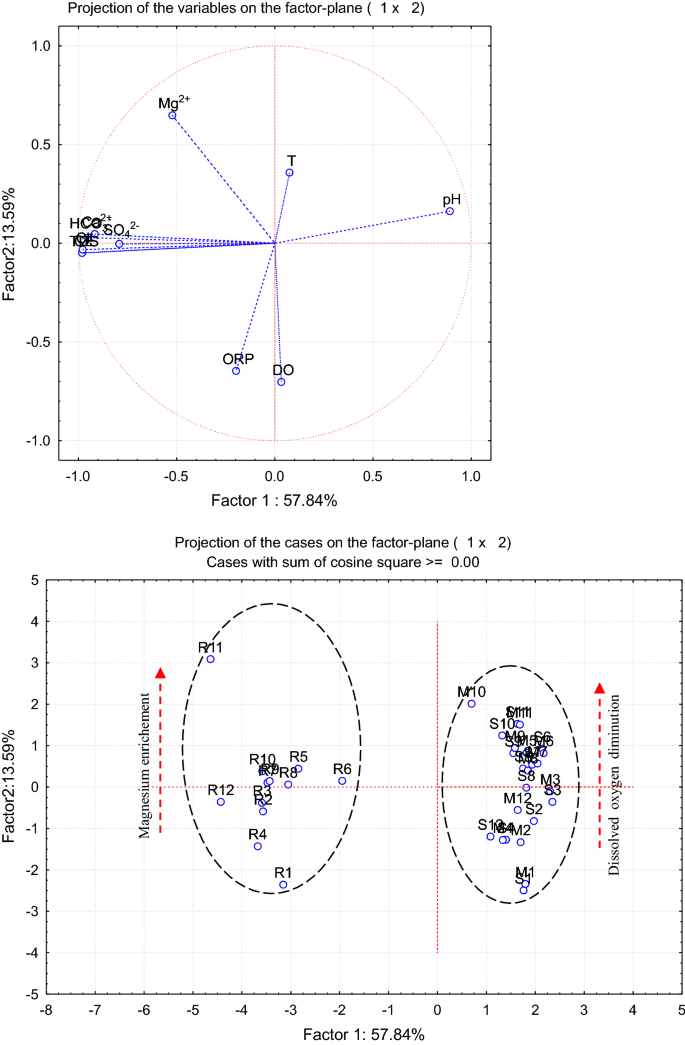Abstract
The objective of this study conducted from October to December 2020 in the Natural Resources and Sensitive Environment Development Laboratory was to demonstrate the importance of conservation protocols respect throw evolution of water chemistry. Ninety-nine samples representing three water types (tap, spring and mineral water) were analyzed. Storage was at laboratory temperature with no conservation protocol. Studied parameters (temperature, pH, CE, dissolved oxygen, oxydo-reduction potential, total dissolved solids, HCO3−, Ca2+, Mg2+, SO42− and Cl−) were determined using standard methods. The data registered from physico-chemical parameters were subjected to different analytical methods to assess the time affect on their values compared with initial state. The results indicate that pH and alkalinity (exprimed in HCO3−) are the most vulnerable to evolution processes with highly significant time factor effect, while the concentrations of chlorides and sulfates with conductivity levels are statistically less evolved. PCA analysis accounting 71.43% of the total variance examines contribution of water type composition as a second variation factor. Projection through F1*F2 plan demonstrates clearly two groups with surface waters (tap water) which are excessively mineralized and groundwaters (spring and bottled waters) in which pH and magnesium parameters variations are the best illustrated.
Similar content being viewed by others
Introduction
Water chemistry deals with the fundamental chemical properties of water itself, the chemical properties of other constituents that dissolve in water, and the countless chemical reactions that take place in water(Theodore and Ryan Dupont 2019). Water chemistry is important because several factors about water to be treated and then distributed or returned to the environment are determined through simple chemical analysis. Probably the most important determination that the water practitioner makes about water is its hardness(Spellman 2020).
Good interpretation of water sample analysis results requires strict adherence to sampling and conservation protocols. There are two types of elements: those that must be analyzed immediately (without delay) and others—with preservatives—which can be stored for months until their analysis. Passing storage precautions may lead to a modification of waters composition (increasing or decreasing contents).
If a water sample cannot be analyzed immediately after collection, it must be stabilized until analysis to prevent or slow down various chemical or biological processes. Preservation techniques include pH control, addition of preservatives, temperature control and protection from light (Lallemand-Barrès 1993).
Several investigations tried to determine the effect of sampling temperature, bottle cleanliness and analysis time on the representativeness of the characterization(Ferland 2014). Using uncleaned bottles during sampling increase the Suspended solids and volatile suspended solids values and decrease the chemical demand of oxygen (COD), biological demand of oxygen (BOD5), NH4+ and PO43− values compared to samples taken with clean bottles according to standard recommendations (Muirhead et al. 2006). Wastewater acidification allows the conservation of COD and BOD5C. Freezing wastewater allows the conservation of BOD5C and COD (Henze et al. 2008). A study by Nopens et al. (2001) demonstrates that a pH maintained at 3 in wastewater allows total and soluble COD to be retained. The main objective of this study was to determine the effect of exceeding storage standards on some parameters over a long period for that daily monitoring of three types of natural water was based on electrochemical measurements and some major elements were carried out.
Materials and methods
Samples choice
This study has an essentially qualitative aim realized throw quantitative analysis. The hypothesis of having different behavior of evolution of the studied parameters led to the choice of three types of natural waters: tap water as surface water (drinking water from dam waters), spring water and bottled mineral water (Texanna) as groundwaters. The tap water and the spring water came from the region of Oum el Bouaghi located in the north eastern Algeria and characterized by semi-arid conditions.
Sampling
Ninety-nine samples were taken on October 15, 2020 andcollected in 500-ml polyethylene bottles completely filled to avoid contact with ambient air. Then, transported to the laboratory (The transport time was approximately 15 min), the first sample was immediately analyzed.
The rest of the samples were left at laboratory temperature and analyzed after every 48 h. In total, 33 analyses by water type were carried out at the Natural Resources and Sensitive Environment Development Laboratory (RNAMS) at Larbi ben m’hidi University, Oum el Bouaghi.
Parameters
Temperature, pH, electrical conductivity, dissolved oxygen, oxydo-reduction potential and total dissolved solid were determined using the potentiometric method using a multi-parameter HANNA HI9829 type.
Alkalinity was determined by the titrimetric method using 0.02 N hydrochloric acid. Calcium and magnesium are also titrimetrically titrated with ethylene diamide tetra acetic acid (EDTA) in the presence of murexide and black erichrome, respectively, as color indicators. The chlorides were determined according to the Mohr method in the presence of silver nitrate solution at 0.0282 M (Rodier and Legube 2009).
UV–Visible spectrophotometry was used to determine sulfates in an acid solution with the presence of a combined reagent: barium chlorides and tween20 solution. Barium sulfates held in suspension are easily quantified at 420 nm wavelength (Rodier and Legube 2009). The results are expressed in milligrams per liter of each of the chemical parameters.
Data analysis
Statistical analyses were performed using Xl-STAT software. The descriptive statistics concerned electrochemical measurements and major elements. All three types of water and storage time were considered to be factors with three replications.
Analysis of variance (ANOVA) was used to make multiple comparisons. The means were compared and the differences were considered significant at the odds threshold at P < 0.05.
Table 1 represents the conservation norms of water samples. Results obtained later will be compared to them.
Results and Discussion
ANOVA results
Analysis of variance (Table 2) revealed the presence of a non-significant time (day) effect on electrical conductivity and total dissolved solids (TDS) and significant to a very highly significant effect on the rest of the measured parameters of the water samples. It also showed a very highly significant effect of water type on all measured variables except dissolved oxygen, which represents relatively similar values in the three types of water (Table2).
For the two parameters sulfate and chloride, the measurements are carried out weekly; therefore, they were separately exposed to an analysis of variance. This showed the absence of significant variations between the different weeks for two variables. On the other hand, it revealed the existence of a very highly significant effect of water nature on them.
Water chemistry evolution
Time effect on daily measured parameters
Electrochemical parameters
Temperature Since the analyzed waters are exposed to ambient temperature, their temperature is strongly influenced by its changes.Days 71, 43, 36, 15, 34, 17, 72, 39, 67 and 41 are characterized by relatively high temperatures, dropping from 20.53 ± 0.25° C to 22.1 ± 0.30° C, while the days 74 and 76 are characterized by low temperatures (15.47 ± 0.25 and 15.20 ± 0.26° C, respectively) and the rest of the days record intermediate temperatures (between 16 and 20° C).
pH Water pH is an important chemical property that controls the distribution of chemical species invarious forms. For example, the pH is buffered at precise values in animal cells to maintain the functionality of specific enzymes and proteins. It is important to measure water pH in Situ because samples are susceptible to temperature variations (Larson 1975; Kohlmann 2003).
In closed systems, every change in sample temperature induces a change in hydrogen ion activity. A diminution of 0.45 was recorded in pure water if the temperature is raised to 25 °C(Langelier 1946).
Water that is not in equilibrium with the atmosphere (groundwater) may change when exposed to the atmosphere; therefore, sample containers should be filled entirely without agitating and stirring and measured in a closed system if possible. Schock (2013) demonstrates the effect of CO2 loss on pH when the sample is exposed to the atmosphere at 25 °C.
pH registered values show that the water concerned by this study has increased significantly (Fig. 1b) compared with the initial state. It should be noted that there are no preservation methods for this parameter and the analysis must be carried out within 6 h after sampling.
In the first week, the pH values recorded of the waters are relatively low (7.36 ± 0.55, 7.43 ± 0.56, 7.40 ± 0.44 and 7.45 ± 0.54 which constitute the G group). In the second week, the values of this parameter increase and reach the maximum values (7.86 ± 0.53, 7.90 ± 0.44, 7.94 ± 0.50 and 7.93 ± 0.51 and form the homogeneous group A, the rest of the weeks and until the end of the test the pH indicates intermediate values.
There are no agents that can stabilize alkalinity and acidity;these parameters are determined in the field immediately after sampling (Barcelona and Helfrich 1986; Barker and Dickhout 1988);for that,results showed significant variations in time.
Electrical conductivity Micro siemens per centimeter is the used unit for EC measurements. Water conductivity may be controlled by various factors like geology, atmospheric inputs, evaporation, some microbial metabolism, etc.
Depending on which electrolytes are present, the electrical conductivity increases 1–3%/°C (Robinson and Stokes 1965). Therefore, electrical conductivity is typically reported at 25 °C to standardize the effect of temperature. The conductivity of natural water can be calculated from their chemical composition. Interpretation of results is based on temperature and TDS data.
Figure 1c explores the daily variation of conductivity in the three water types. No significant variations were noted over 78 days. Separately represented, EC values correlations with temperature are most illustrated for tap water. This is probably due to their excessive mineralization.
Dissolved oxygen Dissolved oxygen (DO) is a vital component in determining the health of aquatic systems. Its rates are highly dependent on temperature, atmospheric pressure and biota metabolism (respiration and photosynthesis).
In the current study, atmosphere-water surface exchange is canceled. The statistical data analysis reveals a tendency for a decrease in dissolved oxygen over time. Studied waters were driven to anoxic conditions, the highest values were detected at the start of the test; 17.13 ± 1.36 on the first day (group A) and 16.53 ± 3.07 on the thirteenth day (group C), while those lowest are recorded at the end of the test (9.2 ± 0, 6 on the last day, 8.92 ± 0.28 on the 71st day and 8.91 ± 3.62 on the 64th day thus representing group D).
Major anions and cations
Alkalinity (HCO3−) The protocol for determining alkalinity by standard methodology is presented by Eaton et al. (2005). The traditional procedure for alkalinity is to measure how much H+ is required to titrate a sample in the presence of methyl orange to the endpoint (about pH 4.5). The pH at the titration endpoint corresponds approximately to the point where an amount of H+ has been added to react with all the OH−, CO32−, and HCO3− in the sample to produce CO2 and H2O. The milliequivalents of H+ used in the titration multiplied by 50.04 mg CaCO3/meq is the alkalinity.
Limestone is a major source of alkalinity and hardness. This substance varies in composition ranging from CaCO3 (calcite) toMgCO3.CaCO3 (dolomite), but most limestone is a mixture of CaCO3 and MgCO3 in which CaCO3 is most abundant (Bowles 1956).
The discussion of alkalinity evolution is possible only in the case of comparison with the temperature evolution curve. Carbon dioxide enters the water from the atmosphere and the respiration of aquatic organisms.
The solubility of CO2 in water depends on atmospheric pressure, the concentration of CO2 in the atmosphere, water temperature and salinity, according to the following formula:
CO2 + H2O = H+ + HCO3−
In Fig. 2, fluctuations in alkalinity expressed in HCO3− are a function only of temperature and salinity as the effect of atmospheric CO2 and pressure are canceled. Variations are significant and the respect of sampling norms for this parameter is required (24 h).
The bicarbonate values oscillate between 16.94 ± 8.64 mg/l. The value marked on the 11th day is 105.39 ± 51.36 mg/l., and the value recorded on the 62nd day, an increase of 88.45 mg /l indicates the instability of this element during water storage.
Chlorures The mean values of the chlorides of the studied samples pass from 95.56 mg / l; value recorded at the Third week at 133.33 mg / l; value marked at the 12th week. The contents of drinking water studied in this element represent values; statistically similar over the 12-week study.
Sulfate The average sulfate content of the three types of drinking water analyzed varies between 27.58 mg/l; value recorded at the 2nd week and 111.69 mg/l; value observed at the end of the test (12th week), i.e., a difference of 84.11 mg / l (Fig. 2.c). This increase remains statistically insignificant, which requires the hypothesis of the stability of sulfate concentrations during the period of water storage, at least during the three months of testing.
Calcium Ca2+ Calcium is an alkaline earth metal that is extremely common in nature especially, in calcareous rocks in the form of carbonates. A major component of water hardness, calcium is generally the dominant element in drinking water. Its levels vary essentially according to land geology.
Results revealed that initial calcium levels are relatively lower than final levels.
Magnesium Mg2+ The temporal variation of the magnesium content of the water studied indicates the presence of an increasing trend over time with a correlation coefficient r equal to 0.67. This tendency has made it possible to highlight three homogeneous groups: groups A, B, and C.
Water type effect on daily measured parameters
As was observed by the analysis of variance, the effect of the nature of drinking water is very highly significant on all the parameters measured except dissolved oxygen. This means that there are significant differences between all types of water studied (Table 3).
The comparison of the means of the variables measured on the three types of drinking water indicates that tap water represents the highest values for the majority of the parameters measured (temperature, electrical conductivity, redox power, the level of dissolved salts, bicarbonate, calcium, magnesium, sulfate and chloride) compared to other types of water, thus building group A. This water, on the other hand, has a relatively lower pH. Mineral water shows average values of temperature and dissolved oxygen similar to tap water. For the rest of the parameters measured, its values seem closer to that of spring water except the pH, where each type of drinking water falls into a different group.
Global data correlations (Principal component analysis)
Explaining variations and correlations in global hydrochemical and water quality data using PCA projections is widely developed. The purpose of this analysis is to transform the data table into a new orthogonal and uncorrelated set of factors called principal components (PC) and to extract significant information from the data. This new representation compresses the data by keeping only the most important information, simplifying the explanation, and exploring the structure and composition of the data(Abdi and Williams 2010). The proximity of lines for two variables signifies the strength of their reciprocal association (Qu and Kelderman 2001).
In the present study, PCA was applied (using XLSTAT software)to physical and chemical parameters (variables) of the ninety-nine groundwater samples (observations) from three water types to explain similarities and variations during a period of time.
Factor F1 (Fig. 3) explains 57.84% of the variance and correlated with 70% of variables (pH, CE, TDS, HCO3−, Ca2+, Cl− and SO42−). This factor represents highly mineralized waters (Tap water), in which water chemistry evolution is the best illustrated.
Factor F2 explains 13.59% of the variance. It has a negative correlation with dissolved oxygen and a positive correlation with ORP and Mg2+. This factor represents water enrichment by Magnesium associated with groundwater indicating intensive photosynthetic algae activity and microbial oxygen consumption. This factor demonstrates that the biological activity mainly influences spring and bottled mineral water.
Conclusions
Multivariate statistics were applied to hydrochemical data of three water types belong 78 days. This study shows the usefulness of analysis of variances (ANOVA) to identify significant relationships between measured parameters levels evolution with time. It also allows the understanding of the specific behavior of each water type and the complexity of factors that control water chemistry.
Applied methods explain modalities of temporal variability of eleven parameterswhich can be divided into (1) parameters with non-significant variations such as electrical conductivity, total dissolved solids, sulfates and chlorides. It is important to mention that even their conservation protocols time is too long. (2) Parameters with significant variations such as calcium and (3) parameters with high signification such as dissolved oxygen, pH, bicarbonates, magnesium and ORP in which conservation delay do not exceed 24 h.
Filling and hermetic sealing of the bottle cannot be considered a means of long-term preservation, but it increases the storage time. To conclude, the correct execution of conservation protocols ensures the quality and reliability of the obtained results.
Further studies should incorporate the evolution of BOD5, COD and Organic matter for more parameters investigation.
References
Abdi H, Williams LJ (2010) Principal component analysis. Wiley Interdiscipl Rev Comput Stat. https://doi.org/10.1002/wics.101
Barcelona MJ, Helfrich J-A (1986) Well construction and purging effects on groundwater samples. Environ Sci Technol. 20:1179–1184. https://doi.org/10.1021/es00153a015
Barcelona MJ, Gibb JP, Helfrich JA, Garske EE (1985) Practical guide for groundwater sampling. EPA/ 600/2–85/104
Barker J, Dickhout R (1988) An evaluation of some systems for sampling gas charged groundwater for volatile organic analysis. Groundwater Monit R 8:112–120. https://doi.org/10.1111/j.1745-6592.1988.tb01111.x
Bowles O (1956) Limestone and dolomite. U.S. Bur of Mines, Inf Circ 7738
Eaton AD, Clesceri LS, Franson MAH, Rice EW, Greenberg AE (2005) Standard Methods for the Examination of Water & Wastewater. American Public Health Association, Washington
Ferland M (2014) Effet des paramètres d'echantillonnage sur la représentativité de la caractérisation des eaux usées. Thèse. École Polytechnique de Montréal
Henze M, Van Loosdrecht MCM, Ekama GA, Brdjanovic D (2008) Biological wastewater treatment – principles, modelling and design. IWA Publishing, London
Kohlmann FJ (2003) What is pH and how is it measured: a technical handbook for industry. Hach company, Ames
Lallemand-Barrès A (1993) Guide pratique d'echantillonnage des eaux souterraines. france: BRGM n°R37390
Langelier WF (1946) Effect of temperature on the pH of natural waters. J Am Water Work Assoc 38:179–185
Larson TE (1975) Corrosion by domestic waters. Urbana Illinois (Bulletin 59)
Muirhead WM, Farmer G, Walker S, Robb L, Elmendorf H, Matthews R, Melcer H (2006) Study of raw wastewater BOD5 and cBOD5 relationship yields surprising results Paper presented at the WEFTEC. October, Dallas,TX. https://doi.org/10.2175/193864706783749459
Nopens I, Capalozza C, Vanrolleghem PA (2001) Stability analysis of a synthetic municipal wastewater. University of Gent, Belgium
Qu W, Kelderman P (2001) Heavy metal contents in the Delft canal sediments and suspended solids of the River Rhine: multivariate analysis for source tracing. Chemosphere. 45:919–925. https://doi.org/10.1016/S0045-6535(01)00101-1
Robinson RA, Stokes RH (1965) Electrolyte solutions. Butterworths Publications Limited, London
Rodier J, Legube B (2009) Merlet N et coll. Dunod, L’analyse de l’eau. Paris
Scalf MR, McNabb JF, Dunlap WJ, Gosby RL, Fryberger JS (1981) Manual of groundwater sampling procedures. National Water Well Association, Westerville
Schock M (2013) Communication personnelle de MR schock. Office of Research and Development, U.S. Environmental Protection Agency , Washington
Spellman FR (2020) The science of water. 4th edition. Imprint CRC Press
Theodore L, Ryan Dupont R (2019) Water resource management issues, 1st edn. CRC Press, Boca Raton
Funding
This research did not receive any specific grant from funding agencies in the public, commercial, or not-for-profit sectors.
Author information
Authors and Affiliations
Contributions
All authors contributed extensively to the work presented in this paper, collect data, designed and performed research, wrote, revised and approved the final manuscript.
Corresponding author
Ethics declarations
Conflict of interest
There is no conflict of interest.
Ethicalapproval
This article does not contain any studies with human participants or animals performed by any of the authors.
Additional information
Publisher's Note
Springer Nature remains neutral with regard to jurisdictional claims in published maps and institutional affiliations.
Rights and permissions
Open Access This article is licensed under a Creative Commons Attribution 4.0 International License, which permits use, sharing, adaptation, distribution and reproduction in any medium or format, as long as you give appropriate credit to the original author(s) and the source, provide a link to the Creative Commons licence, and indicate if changes were made. The images or other third party material in this article are included in the article's Creative Commons licence, unless indicated otherwise in a credit line to the material. If material is not included in the article's Creative Commons licence and your intended use is not permitted by statutory regulation or exceeds the permitted use, you will need to obtain permission directly from the copyright holder. To view a copy of this licence, visit http://creativecommons.org/licenses/by/4.0/.
About this article
Cite this article
Dib, D., Ababsa, N., Addad, D. et al. Experimental research on water chemistry evolution in case of inadequate conservation protocols: application on surface and groundwater. Appl Water Sci 11, 135 (2021). https://doi.org/10.1007/s13201-021-01467-5
Received:
Accepted:
Published:
DOI: https://doi.org/10.1007/s13201-021-01467-5


